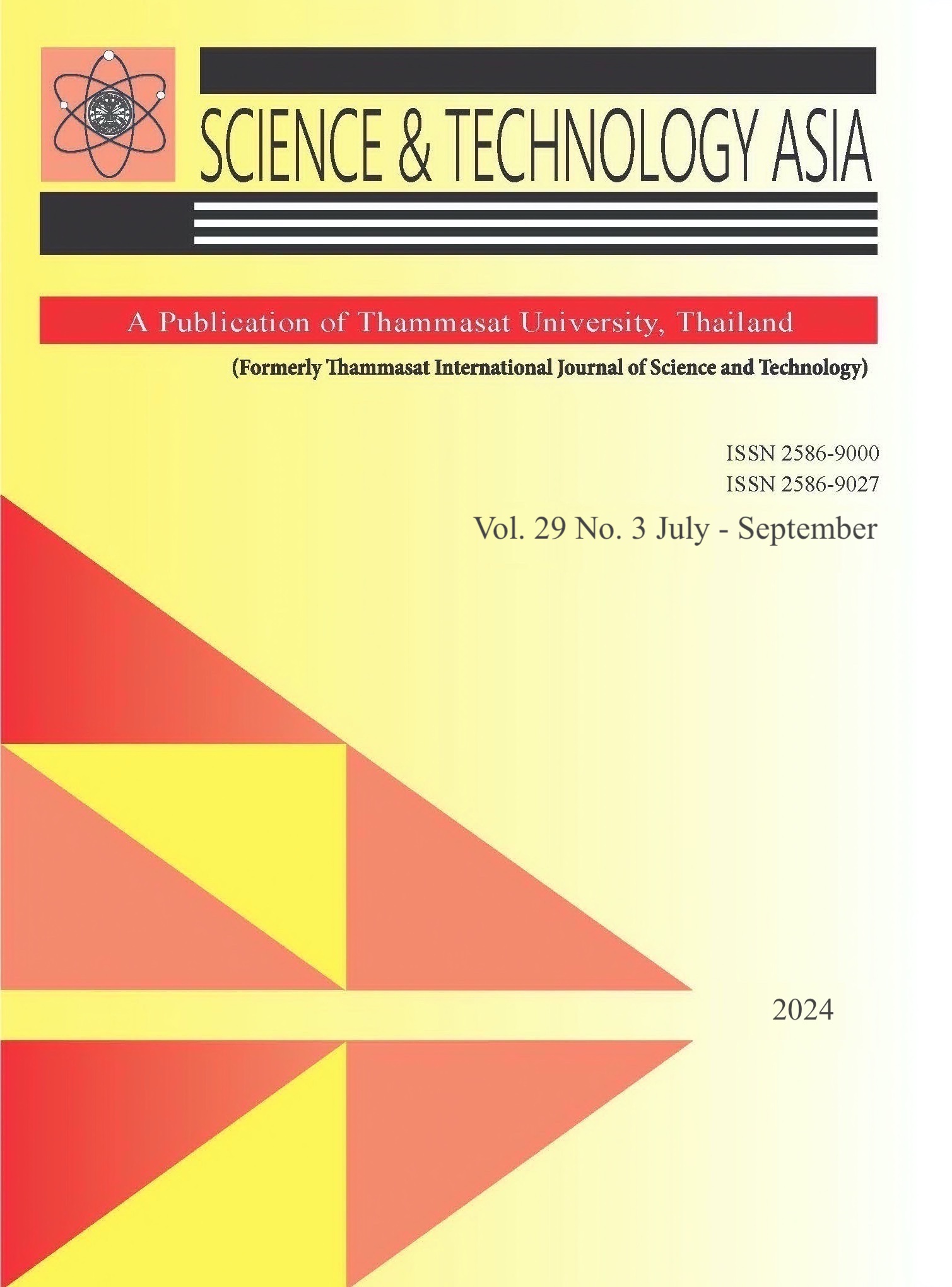Molecular Interactions of Polyphenolic Compounds Binding on Antiapoptotic Wild-Type and Mutated Bcl-2 Proteins
Main Article Content
Abstract
The molecular docking approach was used to determine the binding affinities and the interactions of B-cell lymphoma 2 (Bcl-2) both of wild-type and mutated Bcl-2 (Gly101Val) in complex with five polyphenolic compounds which were reported to have biological activity
in cancer therapy: Hesperetin, Quercetin, Cleomiscosin B, 5'-Methoxy-7'-epi-jatrorin A, and Procyanidin B2. The compounds were found to act as BH3-mimetics. They bind into the hydrophobic groove of BH3 motifs. Procyanidin B2 exhibited favorable binding free energies for both wild-type and mutated Bcl-2 (-8.30 to -8.80 kcal/mol). Molecular dynamics simulations and conformational analysis investigated the dynamics of Procyanidin B2 when bound to Bcl-2 in solution. Procyanidin B2 tightly binds to the hydrophobic groove of wildtype Bcl-2 (-24.79 kcal/mol) compared to the mutated species (-17.15 kcal/mol). Mutated residue in BH3 motifs induced structural changes, widening the hydrophobic cavity. This change potentially allows interference by surrounding water molecules, thereby weakening the protein-ligand interaction.
Article Details

This work is licensed under a Creative Commons Attribution-NonCommercial-NoDerivatives 4.0 International License.
References
Ferlay J, Colombet M, Soerjomataram I, Parkin DM, Piñeros M, Znaor A, et al. Cancer statistics for the year 2020: An overview. International Journal of Cancer. 2021;149(4):778-89.
Sung H, Ferlay J, Siegel RL, Laversanne M, Soerjomataram I, Jemal A, et al. Global Cancer Statistics 2020: GLOBOCAN Estimates of Incidence and Mortality Worldwide for 36 Cancers in 185 Countries. CA: A Cancer Journal for Clinicians. 2021;71(3):209-49.
Pfeffer CM, Singh ATK. Apoptosis: A Target for Anticancer Therapy. International Journal of Molecular Sciences. 2018;19(2):448.
Kale J, Osterlund EJ, Andrews DW. BCL-2 family proteins: changing partners in the dance towards death. Cell Death Differ. 2018;25(1):65-80.
Campbell KJ, Tait SWG. Targeting BCL-2 regulated apoptosis in cancer. Open Biology. 2018;8(5):180002.
Sharma A, Boise L, Shanmugam M. Cancer Metabolism and the Evasion of Apoptotic Cell Death. Cancers. 2019;11:1144.
Chonghaile TN, Letai A. Mimicking the BH3 domain to kill cancer cells. Oncogene. 2008;27(1):S149-S57.
Oltersdorf T, Elmore SW, Shoemaker AR, Armstrong RC, Augeri DJ, Belli BA, et al. An inhibitor of Bcl-2 family proteins induces regression of solid tumours. Nature. 2005;435(7042):677-81.
Tse C, Shoemaker AR, Adickes J, Anderson MG, Chen J, Jin S, et al. ABT-263: A Potent and Orally Bioavailable Bcl-2 Family Inhibitor. Cancer Research. 2008;68(9):3421-8.
Suvarna V, Singh V, Murahari M. Current overview on the clinical update of Bcl-2 anti-apoptotic inhibitors for cancer therapy. European Journal of Pharmacology. 2019;862:172655.
Souers AJ, Leverson JD, Boghaert ER, Ackler SL, Catron ND, Chen J, et al. ABT-199, a potent and selective BCL-2 inhibitor, achieves antitumor activity while sparing platelets. Nat Med. 2013;19(2):202-8.
Birkinshaw RW, Gong J-n, Luo CS, Lio D, White CA, Anderson MA, et al. Structures of BCL-2 in complex with venetoclax reveal the molecular basis of resistance mutations. Nature Communications. 2019;10(1):2385.
Ferreira de Oliveira JMP, Santos C, Fernandes E. Therapeutic potential of hesperidin and its aglycone hesperetin: Cell cycle regulation and apoptosis induction in cancer models. Phytomedicine. 2020;73:152887.
Primikyri A, Chatziathanasiadou MV, Karali E, Kostaras E, Mantzaris MD, Hatzimichael E, et al. Direct binding of Bcl-2 family proteins by quercetin triggers its pro-apoptotic activity. ACS Chem Biol. 2014;9(12):2737-41.
Lee Y. Cancer Chemopreventive Potential of Procyanidin. Toxicological Research. 2017;33(4):273-82.
Omid G. Cytotoxicity and Apoptosis Induction by Coumarins in CLL. In: Tülay Aşkin Ç, editor. Cytotoxicity. Rijeka: IntechOpen; 2018.Ch. 6. p. 90-114.
BIOVIA DS. Discovery Studio Visualizer 2020 [Available from: https://discover.3ds.com/discoverystudio-visualizer-download.
Morris GM, Huey R, Lindstrom W, Sanner MF, Belew RK, Goodsell DS, et al. AutoDock4 and AutoDockTools4: Automated docking with selective receptor flexibility. J Comput Chem. 2009;30(16):2785-91.
Cosconati S, Forli S, Perryman AL, Harris R, Goodsell DS, Olson AJ. Virtual screening with AutoDock: theory and practice. Expert Opinion on Drug Discovery. 2010;5(6):597-607.
Morris GM, Goodsell DS, Halliday RS, Huey R, Hart WE, Belew RK, et al. Automated docking using a Lamarckian genetic algorithm and an empirical binding free energy function. Journal of Computational Chemistry. 1998;19(14):1639-62.
Case D, Aktulga, H.M., Belfon, K., Ben-Shalom, I., Brozell, S., Cerutti, D., Cheatham T., Cruzeiro V., Darden T., Duke R., Giambasu G., Gilson M., Gohlke H., Götz A., Harris R., Izadi S., Izmailov S., Jin C., Kasavajhala K., & Kollman, P. Amber 2021. (2021).
Linse J-B, Hub JS. Three- and four-site models for heavy water: SPC/E-HW, TIP3P-HW, and TIP4P/2005-HW. The Journal of Chemical Physics. 2021;154(19).
Wang LP, McKiernan KA, Gomes J, Beauchamp KA, Head-Gordon T, Rice JE, et al. Building a More Predictive Protein Force Field: A Systematic and Reproducible Route to AMBER-FB15. J Phys Chem B. 2017;121(16):4023-39.
Ryckaert J-P, Ciccotti G, Berendsen HJC. Numerical integration of the cartesian equations of motion of a system with constraints: molecular dynamics of n-alkanes. Journal of Computational Physics. 1977;23(3):327-41.
Genheden S, Ryde U. The MM/PBSA and MM/GBSA methods to estimate ligand-binding affinities. Expert Opin Drug Discov. 2015;10(5):449-61.
Ramírez D, Caballero J. Is It Reliable to Take the Molecular Docking Top Scoring Position as the Best Solution without Considering Available Structural Data? Molecules. 2018;23(5):1038.
Cory S, Roberts AW, Colman PM, Adams JM. Targeting BCL-2-like Proteins to Kill Cancer Cells. Trends Cancer. 2016;2(8):443-60.
Denis C, Sopková-de Oliveira Santos J, Bureau R, Voisin-Chiret AS. Hot-Spots of Mcl-1 Protein. Journal of Medicinal Chemistry. 2020;63(3):928-43.


